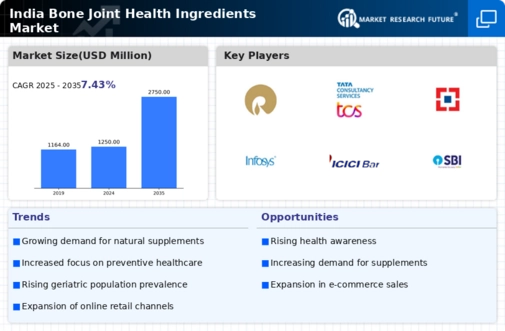Rising Health Awareness
There is a notable increase in health awareness among the Indian population, which is driving the bone joint-health-ingredients market. Consumers are becoming more informed about the importance of maintaining bone and joint health, leading to a surge in demand for dietary supplements and functional foods. This trend is reflected in the growing sales of products containing glucosamine, chondroitin, and collagen, which are known for their joint-supporting properties. Market data indicates that the segment for joint health supplements is expected to grow at a CAGR of approximately 8% over the next five years. This heightened awareness is prompting manufacturers to innovate and market their products more effectively, thereby expanding their reach in the bone joint-health-ingredients market.
Growing Aging Population
The increasing aging population in India is a pivotal driver for the bone joint-health-ingredients market. As individuals age, they often experience a decline in bone density and joint health, leading to a higher prevalence of conditions such as osteoporosis and arthritis. This demographic shift is expected to result in a growing demand for supplements and ingredients that support joint health. According to estimates, the elderly population in India is projected to reach 300 million by 2050, which could significantly boost the market for bone joint-health-ingredients. Manufacturers are likely to focus on developing products tailored to this demographic, thereby enhancing their market presence and catering to the specific needs of older adults.
Supportive Government Initiatives
Government initiatives aimed at promoting health and wellness are playing a crucial role in the growth of the bone joint-health-ingredients market. Programs focused on preventive healthcare and nutrition are encouraging consumers to adopt healthier lifestyles, which includes the use of dietary supplements. The Indian government has been actively promoting awareness campaigns about bone health, particularly among vulnerable populations. Such initiatives are likely to create a conducive environment for the market, as they not only educate consumers but also encourage manufacturers to align their products with national health objectives. This supportive framework may lead to increased investment in the bone joint-health-ingredients market, fostering innovation and expanding product availability.
Increased Incidence of Joint Disorders
The rising incidence of joint disorders in India is a significant driver for the bone joint-health-ingredients market. Factors such as sedentary lifestyles, obesity, and poor dietary habits contribute to the prevalence of conditions like osteoarthritis and rheumatoid arthritis. Reports suggest that nearly 15 million Indians suffer from osteoarthritis, creating a substantial demand for effective joint health solutions. This trend is likely to encourage the development of specialized ingredients and formulations aimed at alleviating joint pain and improving mobility. As healthcare providers increasingly recommend dietary supplements as part of treatment plans, the market for bone joint-health-ingredients is expected to expand, catering to a growing population seeking relief from joint-related issues.
Emergence of Innovative Product Formulations
Innovation in product formulations is emerging as a key driver in the bone joint-health-ingredients market. Manufacturers are increasingly focusing on developing advanced formulations that combine multiple beneficial ingredients to enhance efficacy. For instance, products that blend glucosamine with turmeric or omega-3 fatty acids are gaining traction due to their synergistic effects on joint health. This trend is likely to attract health-conscious consumers looking for comprehensive solutions. Additionally, the introduction of plant-based and vegan alternatives is appealing to a broader audience, further driving market growth. As companies invest in research and development, the variety and quality of offerings in the bone joint-health-ingredients market are expected to improve, catering to diverse consumer preferences.

















Leave a Comment